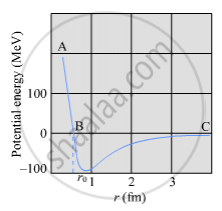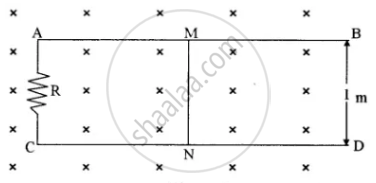Advertisements
Advertisements
प्रश्न
Draw a plot of potential energy between a pair of nucleons as a function of their separation. Mark the regions where potential energy is (i) positive and (ii) negative.
उत्तर

The potential energy is minimum at ro. For distances larger than ro the negative potential energy goes on decreasing and for the distances less than ro the negative potential energy decreases to zero and then becomes positive and increases abruptly.
Thus, A to B is the positive potential energy region and B to C is the negative potential energy region.
APPEARS IN
संबंधित प्रश्न
Define mobility of a charge carrier
Two charged spherical conductors of radii R1 and R2 when connected by a conducting wire acquire charges q1 and q2 respectively. Find the ratio of their surface charge densities in terms of their radii.
Why should electrostatic field be zero inside a conductor?
Draw a plot of potential energy of a pair of nucleons as a function of their separation.
what is the significance of negative potential energy in the graph drawn?
AB and CD are two parallel conductors kept 1 m apart and connected by a resistance R of 6 Ω as shown in Figure below. They are placed in a magnetic field B = 3 × 10-2 T which is perpendicular to the plane of the conductors and directed into the paper. A Wire. MN is placed over AB and CD. and then made to slide with a velocity 2 ms-1 (Neglect the resistance of AB, CD, and MN.)

Calculate the induced c.urrent flowing through the resistor R.
A long, hollow conducting cylinder is kept coaxially inside another long, hollow conducting cylinder of larger radius. Both the cylinders are initially electrically neutral ______.
Two spherical conductors each of capacity C are charged to potential V and -V. These are then connected by means of a fine wire. The loss of energy is ______.
A 4µF condenser is charged to 400 volts and then plates are joined through a resistance of 1 kΩ The heat produced in the resistance is:
A conductor has a 14.4 × 10-19 coulomb positive charge. The conductor has ______
(Charge on electron = 1.6 × 10-19 coulomb)
